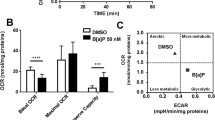Abstract
Nine human tumor cell lines derived from both epithelial and mesenchymal tumors exhibited either an anchorage-independent growth non-tumorigenic phenotype or an anchorage-independent tumorigenic phenotype. Transformed epithelial cell lines with the non-tumorigenic phenotype could be converted to a progressively growing tumor phenotype following treatment with either methylmethane sulfonate (MMS) or N-methyl-N′-nitro-N-nitrosoguanidine (MNNG). In contrast, sarcoma derived cell lines with a non-tumorigenic phenotype could be converted to a progressively growing tumor phenotype only with MNNG. SV40 immortalized HET-1A non-tumorigenic phenotype cells could be converted to a progressively growing tumorigenic phenotype, infrequently, when treated with MNNG, but not MMS. Progressively growing tumors produced by either MMS or MNNG treated non-tumorigenic phenotypes exhibited metastatic potential in nude mice. Chemically treated HET-1A cells acquired the ability to produce tumor in mice but the tumor did not exhibit metastatic potential. In contrast, populations of tumorigenic cells were not rendered more biologically aggressive after treatment with either MMS or MNNG; i.e., the latency period for tumor development was not accelerated and the tumors did not exhibit metastatic potential. These results suggest that the biological effects of MMS and MNNG on non-tumorigenic, tumorigenic and immortalized cell lines are phenotype specific.
Similar content being viewed by others
Abbreviations
- AIG:
-
anchorage-independent growth
- DMSO:
-
dimethyl sulfoxide
- FBS:
-
fetal bovine serum
- GM:
-
growth medium
- MEM:
-
Eagle's minimum essential medium
- MMS:
-
methylmethane sulfonate
- MNNG:
-
N-Methyl-N′-Nitro-N-Nitrosoguanidine
- PDL:
-
population doubling
- SCC:
-
squamous cell carcinoma
References
CHEN, J-C., SHULER, C.F., ZHANG, C.X., SCHULLER, D.E., and MILO, G.E. (1991). “Histopathologic comparison between human oral squamous cell carcinomas and their xenografts in nude mice.” Oral Surg. 71: 457–463.
BLAKESLEE, J.R., YOHN, D.S., MILO, G.E., and HART, R.W. (1976). “Interaction between chemical carcinogens, oncogenic viruses, and 17-β-estradiol.” In: Comparative Leukemia Research, Bibl. Haemat., No. 43 (J. Clemmesen and D.S. Yohn, eds.). p. 481–483. S. Karger and A.G. Basel.
DIPAOLO, J.A., WOODWORTH, C., POPESCU, N.C., NOTARIO, V. and DONIGER, J. (1989). “Induction of human cervical carcinoma by sequential transfection with human papillomavirus 16.” Oncogene 4: 395–399.
HEPPNER, G.H. (1984). “Tumor heterogenicity.” Cancer Res. 44: 2259–2265.
JONES, P. (1986). “DNA methylation and cancer.” Cancer Res. 46: 461–466.
KERBEL, R.S., FROST, P., LITEPLO, R., CARLOW, D.A. and ELLIOT, B.E. (1984). “Possible epigenetic mechanisms of tumor progression: Induction of high-frequency heritable but phenotypically unstable changes in the tumorigenic and metastatic properties of tumor cell populations by 5-azacytidine treatment.” J. of Cellular Physiology Supplement 3: 87–97.
KUMARI, H.L., SHULER, C.F., LEHMAN, T., FERRONE, S. and MILO, G.E. (1989). “Development of neoplastic phenotype following transfection of HNF cells with sarcoma DNA.” Carcinogenesis 2: 401–404.
KUMARI, H.L., SHULER, C., MANNIX, D. and MILO, G.E. (1990). “HNF transfection with chondrosarcoma DNA results in the development of a sarcoma cell surface associated epitope.” Exp. Molec. Pathol. 53: 167–179.
KURIAN, P.K., NESNOW, S., AND MILO, G.E. (1990). “Quantitative evaluation of the effects of human carcinogens and related chemicals on human foreskin fibroblasts.” Cell Biol. and Toxic. 6: 171–184.
LEHMAN, T.A., NOYES, I., and MILO, G.E. (1986). “Establishment and chemical transformation of human skin epithelial cells in vitro.” J. of Tissue Culture Methods 10: 197–203.
MILO, G., NOYES, I., DONOHOE, J., and WEISBRODE, S. (1981). “Neoplastic transformation of human epithelial cells in vitro after exposure to chemical carcinogens.” Cancer Res. 41: 5098–5102.
MILO, G.E. and CASTO, B.C. (1986). “Conditions for transformation of human fibroblast cells: An overview.” Cancer Letters 32: 1–13.
MILO, G.E., CASTO, B. and FERRONE, S. (1987). “Comparison of features of transformed cells in vitro with human sarcoma-derived cells.” Mutation Res. 199: 387–398.
MILO, G., YOHN, J., SCHULLER, D., NOYES, I., and LEHMAN, T. (1989). “Comparative stages of expression of human squamous carcinoma cells and carcinogen transformed keratinocytes.” J. of Invest. Derm. 92: 848–853.
MILO, G.E., SHULER, C., KURIAN, P., FRENCH, B.T., MANNIX, D.G., NOYES, I., HOLLERING, J., SITAL, N., SCHULLER, D. and TREWYN, R.W. (1990). “Nontumorigenic squamous cell carcinoma line converted to tumorigenicity with methyl methanesulfonate without activation of HRAS or MYC.” Proc. Natl. Acad. Sci. USA 87: 1268–1272.
NAKAZAWA, H., AGUELON, A-M., and YAMASAKI, H. (1990). “Relationship between chemically induced Ha-ras mutation and transformation of BALB/c cells: Evidence for chemical-specific activation and cell type-specific recruitment of oncogene in transformation.” Molecular Carcinogenesis 3: 202–209.
NESNOW, S., MILO, G., KURIAN, P., SANGAIAH, R. and GOLD, A. (1990). “Induction of anchorage-independent growth in human diploid fibroblasts by the cyclopenta-polycyclic aromatic hydrocarbon, benz(1)aceanthrylene.” Mutat. Res. Letts. 224: 221–225.
REZNIKOFF, C.A., LORETZ, L.J., CHRISTIAN, B.J., WU, S-Q., and MEISNER, L.F. (1988). “Neoplastic transformation of SV40-immortalized human urinary tract epithelial cells by in vitro exposure to 3-methylcholanthrene.” Carcinogenesis 9: 1427–1436.
RHIM, J.S., FUITA, J., ARNSTEIN, P., and AARONSON, S.A. (1986). “Neoplastic conversion of human keratinocytes by adenovirus 12-SV40 virus and chemical carcinogens.” Science 232: 385–388.
SHULER, C., KURIAN, P., FRENCH, B.T., OYES, I., SITAL, N., HOLLERING, J., TREWYN, R.W., SCHULLER, D.E. and MILO, G.E. (1990). “Noncorrelative c-myc and ras oncogene expression in SCC cells with tumorigenic potential.” Teratogenesis Carcinog. Mutagen. 10: 53–65.
SHULER, C.F. and MILO, G.E. (1992). “Morphologic and molecular characterizations of plastic tumor cell populations.” In: Transformation of Human Epithelial Cells: Molecular and Oncogenic Mechanisms (G.E. Milo, B.C. Casto and C.F. Shuler, eds.), pp. 211–234. CRC Press, Inc., Florida.
STONER, G.D., KAIGHN, M.E., REDDEL, R.R., RESAU, J.H., BOWMAN, D., (1991). “Establishment and characterization of SV40T-antigen immortalized human esophageal epithelial cells.” Cancer Res. 51: 365–571.
THRAVES, P., SALEHI, Z., DRITSCHILO, A. and RHIM, J.S. (1990). “Neoplastic transformation of immortalized human epidermal keratinocytes by ionizing radiation.” Proc. Natl. Acad. Sci. USA 87: 1174–1177.
ZATTERSTROM, U.K., WENNERBERG, J., ATTEWELL, R., and ASK, A. (1990). “Squamous cell carcinoma of the head and neck heterotransplanted to nude mice.” Cancer 66: 145–151.
Author information
Authors and Affiliations
Rights and permissions
About this article
Cite this article
Milo, G.E., Shuler, C.F., Stoner, G. et al. Conversion of premalignant human cells to tumorigenic cells by methylmethane sulfonate and methylnitronitrosoguanidine. Cell Biol Toxicol 8, 193–205 (1992). https://doi.org/10.1007/BF00156730
Issue Date:
DOI: https://doi.org/10.1007/BF00156730




